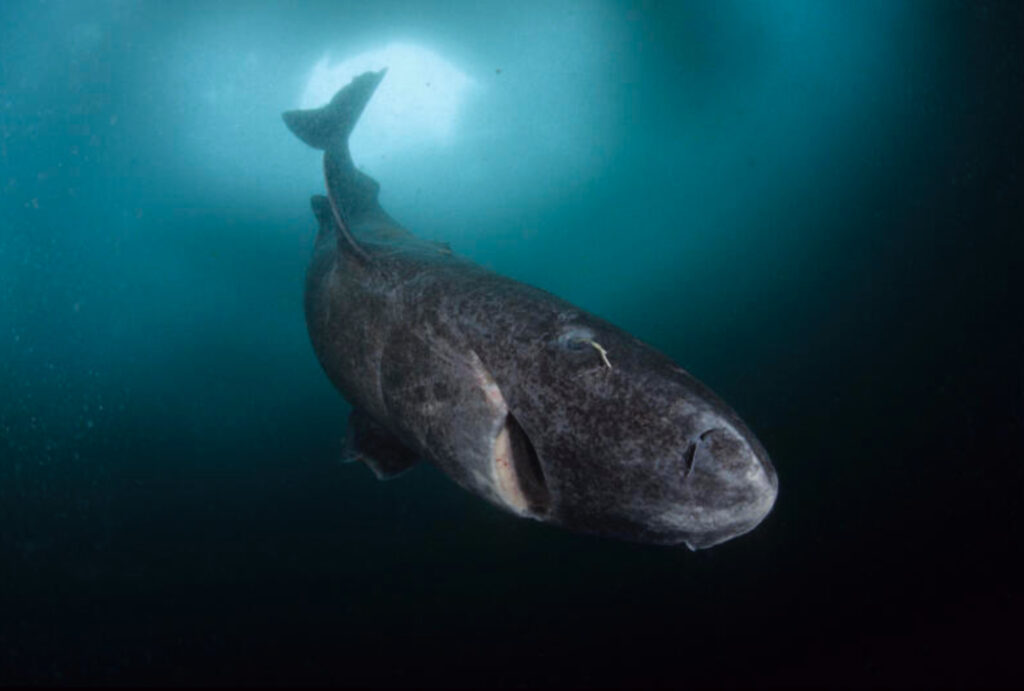
ChatGPT:
The Mysteries of the Greenland Shark: A Deep Dive into the Life of the Longest-Lived Vertebrate
The Greenland shark is one of the most fascinating creatures in the ocean, known for its incredible longevity and enigmatic life deep in the icy waters of the North Atlantic. This shark, which can live for up to 500 years, has become the subject of intense scientific study, as researchers seek to uncover the secrets behind its remarkable lifespan. Despite the progress made in understanding some aspects of its biology, many mysteries still surround this ancient species. This expanded summary delves into the various facets of the Greenland shark’s life, exploring the research conducted to date and the questions that remain unanswered.
🦈 Extreme Longevity and Slow Metabolism
The Greenland shark (Somniosus microcephalus) is an Arctic and North Atlantic species that holds the record for the longest-lived vertebrate, with a lifespan of 300 to 500 years. This exceptional longevity has been attributed to its extremely slow metabolism, a result of living in near-freezing waters. These sharks inhabit depths where the water temperature ranges from -1.8°C to 7.5°C, conditions that slow down their metabolic processes to a crawl. This slow metabolism is thought to be a key factor in their extended lifespan, as it reduces the wear and tear on the body’s tissues and organs over time.
The idea that a slower metabolism leads to a longer life is supported by the “pace-of-life” theory, which links the speed of an animal’s metabolic functions to its lifespan. For example, a hummingbird, which has a very fast metabolism, only lives for a few years, while the Greenland shark, with its sluggish metabolism, can live for centuries. However, scientists like Holly Shiels, a professor of cardiovascular sciences at the University of Manchester, argue that this theory alone doesn’t fully explain the shark’s longevity. Other cold-water species with similarly slow metabolisms live for only a few decades, indicating that there is something unique about the Greenland shark.
❄️ Cold-Water Habitat and Its Effects
The cold, dark depths of the North Atlantic and Arctic Oceans provide a unique environment for the Greenland shark. The shark’s body temperature matches that of the surrounding water, which is close to freezing in its native habitat. This cold environment not only slows down the shark’s metabolism but also affects its overall activity levels. The Greenland shark is a slow-moving animal, with a lethargic swimming style that matches its low-energy lifestyle.
Marine biologists like John Steffensen, a professor at the University of Copenhagen, have been conducting research on the Greenland shark’s behavior and physiology in these extreme conditions. The shark’s slow movement extends to its heart, which beats just 4 to 6 times per minute at rest—a stark contrast to the much faster heart rates seen in most other animals. This extremely slow heart rate is thought to be another factor that contributes to the shark’s longevity, as it reduces the strain on the heart over centuries.
💓 Unique Cardiovascular Traits
The Greenland shark’s cardiovascular system has been a major focus of scientific study, as researchers believe it holds some of the keys to the shark’s longevity. The shark’s heart is particularly intriguing because it appears to resist many of the aging processes that affect the hearts of other animals, including humans.
David McKenzie, a researcher at the French National Centre for Scientific Research (CNRS), has conducted studies on the Greenland shark’s heart by taking electrocardiograms in the frigid waters around Disko Island, Greenland. These studies have revealed that the shark’s heart remains flexible and functional even as it ages, with minimal signs of fibrosis—a condition where the heart tissue becomes stiff and less efficient at pumping blood. This is in contrast to human hearts, which become stiffer and less effective with age, leading to an increased risk of cardiovascular disease.
Pierre Delaroche, a French scientist who completed his thesis in cardiovascular sciences, used electron microscopy to examine the heart cells of the Greenland shark. His findings indicate that the shark’s heart cells maintain their structure and function throughout its life, with no significant decline in the number of mitochondria, the energy-producing components of cells. This is unusual, as in most animals, including humans, the number of mitochondria decreases with age, contributing to the aging process.
🔬 Resistance to Aging
The Greenland shark’s resistance to aging extends beyond its cardiovascular system. The shark’s muscle cells also show remarkable resilience to the effects of time. Doctoral student Ewan Camplisson, who studies the shark’s enzymes, has found that the production and activity of these enzymes do not decline with age, as they do in most other animals. This suggests that the shark’s overall metabolism remains stable throughout its life, further supporting its ability to live for centuries.
This resistance to aging has sparked significant interest among scientists, particularly those studying human longevity. Understanding the mechanisms that allow the Greenland shark to avoid the typical signs of aging could provide insights into how aging might be slowed or even prevented in humans. However, much about the shark’s biology remains a mystery, and researchers are only beginning to scratch the surface of this ancient creature’s secrets.
🌍 Wide Habitat Range and Migration Patterns
While the Greenland shark is primarily found in the cold waters of the North Atlantic and Arctic Oceans, its range may extend much further than previously thought. In 2013, a nearly 4-meter-long specimen was caught in the Gulf of Mexico at a depth of over 1,800 meters. This discovery suggests that the Greenland shark may inhabit a wider range of environments than scientists initially believed, possibly extending across much of the world’s deep oceans.
To better understand the shark’s movements and habitat, researchers like John Steffensen have begun equipping sharks with GPS tags. These tags allow scientists to track the sharks’ migrations and gather data on their range and behavior. However, despite these efforts, much about the Greenland shark’s habitat remains unknown, including where it goes during different times of the year and how far it travels.
❓ Unsolved Mysteries: Reproduction and Genetics
One of the biggest mysteries surrounding the Greenland shark is its reproductive habits. Despite decades of research, scientists have almost never observed young Greenland sharks, and most of the individuals captured are at least 2 meters long and around 50 years old. This raises questions about where and how these sharks reproduce.
Researchers estimate that Greenland sharks reach sexual maturity at around 140 years of age, and their gestation period could last as long as seven to eight years. This extremely slow reproductive rate makes the species particularly vulnerable to overfishing and environmental changes. Historically, the Greenland shark was heavily fished for its liver oil, which was used in lighting and industry. This exploitation may have wiped out an entire generation of sharks, contributing to the scarcity of young individuals observed today.
Another mystery is the Greenland shark’s genetic makeup. Surprisingly, scientists still do not know how many chromosomes the Greenland shark has, and the study of its genetic code is only just beginning. Understanding the shark’s genetics could provide further insights into its longevity and unique biological traits.
⚠️ Threats from Climate Change
The Greenland shark’s cold-water habitat is under threat from global warming. Rising ocean temperatures could shrink the areas where the shark can live, forcing it into smaller and smaller regions of the deep sea. This would not only reduce the shark’s available habitat but could also disrupt its food sources and overall ecosystem.
The potential impact of climate change on the Greenland shark is a major concern for scientists. If ocean temperatures continue to rise, the species could face significant challenges in the coming decades, threatening its survival. This is particularly worrying given the shark’s slow reproductive rate and already vulnerable population.
🧪 The Greenland Shark as a Model for Human Longevity Research
The Greenland shark’s ability to live for centuries without significant signs of aging has made it a valuable model for researchers studying human aging and longevity. By understanding the biological mechanisms that allow the shark to resist aging, scientists hope to uncover new strategies for extending human lifespan and improving health in old age.
The shark’s unique physiology, particularly its cardiovascular and muscular systems, offers insights into how the aging process might be slowed or even reversed. However, the differences between human and shark biology mean that much more research is needed before these findings can be applied to humans.
🔑 Key Takeaways
🦈 Greenland Shark Longevity: The Greenland shark is the longest-lived vertebrate, with a lifespan of up to 500 years, primarily due to its slow metabolism in freezing waters.
❄️ Cold-Water Adaptation: Living in temperatures as low as -1.8°C, the shark’s metabolism and overall activity levels are drastically slowed, contributing to its long life.
💓 Cardiovascular Resilience: The shark’s heart shows minimal signs of aging, with a slow heartbeat and flexible tissues that remain functional even after centuries.
🔬 Muscle and Metabolic Stability: The shark’s muscles and enzymes do not degrade with age, suggesting a unique resistance to aging across its body.
🌍 Wide Habitat Range: While primarily found in the North Atlantic, the Greenland shark’s range may extend much further, with sightings as far south as the Gulf of Mexico.
❓ Reproductive Mysteries: Scientists are still puzzled by the shark’s reproductive habits, as very few young have been observed, and its breeding behavior remains largely unknown.
🧬 Genetic Enigmas: The shark’s genetic code is only beginning to be studied, and researchers still don’t know how many chromosomes it has, leaving much to discover.
⚠️ Climate Change Threats: Rising ocean temperatures could reduce the shark’s cold-water habitat, threatening its survival and the stability of its ecosystem.
🧭 Migration Studies: GPS tagging is helping researchers track the shark’s movements, but much about its migration patterns remains unknown.
🧪 Human Longevity Research: The Greenland shark’s resistance to aging offers potential insights
Q&A
What is the Greenland shark known for?
The Greenland shark is known for its exceptional longevity, living up to 500 years, making it the longest-lived vertebrate.
How does the cold environment affect the Greenland shark?
The cold waters, with temperatures as low as -1.8°C, slow the shark’s metabolism significantly, which contributes to its long lifespan.
Why is the Greenland shark’s heart of particular interest to scientists?
The shark’s heart has a very slow beat, around 4 to 6 times per minute, and shows minimal signs of aging even after centuries, making it an intriguing subject for studying longevity.
What unique characteristic does the Greenland shark’s muscle tissue exhibit?
The shark’s muscle tissue and enzymes do not degrade with age, suggesting a special resistance to aging, unlike most other animals.
What are the current challenges in studying the Greenland shark’s reproductive habits?
Scientists have observed very few young Greenland sharks, and their reproductive behaviors, including where they give birth, remain largely mysterious.
How might climate change affect the Greenland shark?
Rising ocean temperatures could reduce the shark’s cold-water habitat, threatening its survival and the overall ecosystem it depends on.
What potential does the Greenland shark have for human longevity research?
The shark’s resistance to aging could offer insights into slowing or preventing aging in humans, making it a valuable model for longevity studies.
What remains unknown about the Greenland shark’s genetics?
Researchers still do not know how many chromosomes the Greenland shark has, and the study of its genetic code is just beginning.
Where has the Greenland shark been found outside its typical North Atlantic habitat?
A Greenland shark was found in the Gulf of Mexico at a depth of over 1,800 meters, indicating a potentially wider range than previously thought.
What does the “pace-of-life” theory suggest about the Greenland shark’s longevity?
The “pace-of-life” theory suggests that the shark’s slow metabolism, due to its cold environment, contributes to its long lifespan, although this theory alone does not fully explain its longevity.

